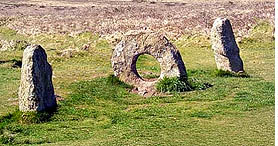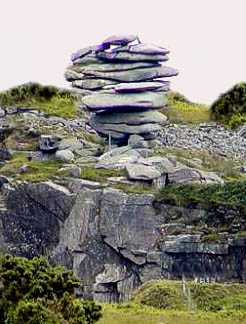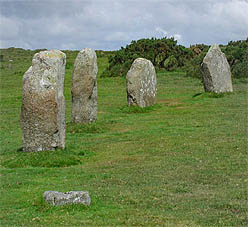Legends of Cornwall's Stones
by Gareth Evans
At the south west extreme of England, surrounded on three sides by sea and almost entirely separated from the rest of Britain by the River Tamar, Cornwall has a quite different character from anywhere else in England. If the Cornish have always seen themselves as a race apart, it is probably because that is exactly what they are, with more in common with the Welsh or Bretons than with their nearest "English" neighbours in Devon, just over the river.
No where is this better reflected than in the rich legacy of uniquely Cornish myths, legends and prehistoric sites. Standing stones in particular are to be found widely throughout the area, sometimes singly sometimes in groups or circles, their often impressive bulk a testament to the ingenuity of the people who sited them over four thousand years ago. With the true reasons for their construction lost in the intervening centuries, fascinating tales grew up to explain the origins of the stones -- often containing a curious mixture of Christian and pagan influences.
From Bodmin Moor to Land's End, the visitor is seldom far from ancient stones in one form or another -- menhir, cairn, dolmen or cromlech -- and their antiquity coupled with the later folklore which developed around them make any minor detour well worth the effort.
Men-An-Tol and Men Scryfa
 The Lands End peninsula is home to one of the most extraordinary standing stones in Europe. About three miles north west of Madron stands Men-An-Tol -- known locally as the "Crick Stone" -- a holed stone, flanked by two upright blocks which may once have been the entrance to a now vanished tomb, or possibly formed part of a solar calendar. It has long been held to have healing powers -- the local name coming from the belief that it could cure rickets and for centuries, afflicted children were passed naked through the stone nine times. Possibly as a result of its obvious symbolism, it was also regarded as an effective way to ensure fertility.
The Lands End peninsula is home to one of the most extraordinary standing stones in Europe. About three miles north west of Madron stands Men-An-Tol -- known locally as the "Crick Stone" -- a holed stone, flanked by two upright blocks which may once have been the entrance to a now vanished tomb, or possibly formed part of a solar calendar. It has long been held to have healing powers -- the local name coming from the belief that it could cure rickets and for centuries, afflicted children were passed naked through the stone nine times. Possibly as a result of its obvious symbolism, it was also regarded as an effective way to ensure fertility.
The Men Scryfa is only a short distance away. Bearing the Latin inscription Rialobrani Cunovali Filii (Rialobran, son of Cunoval) this standing stone is believed to mark the burial place of the legendary king and warrior, who was mortally wounded at the battle of Gendhal Moor. He was reputedly as tall as the nine feet block itself and lies -- in some of the versions at least -- not dead but sleeping beneath it with all his weapons and treasures, ready to answer Cornwall's call in time of need.
The Cheesewring
 At the other end of Cornwall, on Bodmin Moor, this pile of granite slabs takes its name from its similarity to the kind of press formerly used for making cheese. Its true origin is probably natural, but folklore has a much more interesting tale to tell.
At the other end of Cornwall, on Bodmin Moor, this pile of granite slabs takes its name from its similarity to the kind of press formerly used for making cheese. Its true origin is probably natural, but folklore has a much more interesting tale to tell.
Long ago, in a mythical time when Christianity was a new arrival in Britain and a race of giants still populated Cornwall, a grumbling feud developed between them and the Holy Saints. Seeing themselves as the rightful owners of the land, the giants resented these newcomers and particularly their habit of claiming wells as Holy. At a meeting on the Moor, the giants elected Uther, biggest and cleverest of their number, as leader and charged him with ridding them of the Saints, without upsetting the local people, upon whom the giants relied for provisions.
Hearing this discussion, St Tue, a small and physically rather frail man who had himself just declared one of the giants' most important wells to be Holy, decided that the time had come for swift and decisive action. Putting all his trust in God, he challenged Uther to a trial of strength in the form of a rock throwing contest. The saints would leave Britain forever if the giants were to win, but if they lost, they would have to mend their ways and promise to follow Christ forever afterwards. It would seem that rock throwing was a perfectly normal sport for giants and since Uther was widely revered as a champion, presumably he must have thought that the result was a something of a foregone conclusion, to say the least.
The day of the contest dawned and the two contestants gathered their ammunition -- twelve flattish roundish rocks of varying sizes. Uther threw first, tossing a smallish rock with consummate ease onto the summit of nearby Stowe's Hill. Praying for assistance, St Tue found that the heavy rock he handled was as light as a feather and his aim was true Ð his landed on the first, and balanced perfectly atop it. The contest continued and the tower of rocks grew steadily higher. With the score at twelve apiece, Uther called for a thirteenth throw, to settle the matter once and for all. It fell short and rolled back down the hill.
Looking up to the heavens, St Tue bravely strode up to the fallen rock and then clasped it with all his might. Just as he began to try to lift it, an angel appeared, grasped the stone and with gentle beats of its wings, carried it to the distant pile of rocks. An amazed Uther vowed there and then to abandon his evil ways and although some of them returned to their hilltop homes to plot their revenge, most of the giants behaved themselves from that day onward.
The Hurlers of St. Cleer
 Situated on Craddock Moor, not far from the Cheeswring, this site comprises the remains of three stone circles. Although they are thought to have been Druidic originally, as with the Merry Maidens, the legend provides another stern warning to those who would flaunt the Sabbath.
Situated on Craddock Moor, not far from the Cheeswring, this site comprises the remains of three stone circles. Although they are thought to have been Druidic originally, as with the Merry Maidens, the legend provides another stern warning to those who would flaunt the Sabbath.
On this fateful Sunday, the folk of St Cleer and the neighbouring village of St Ives had arranged a game of hurling -- a violent, primitive form of rugby football, with play ranging over the countryside and the goals set several miles apart. With the honour of their respective villages at stake, the players ignored the dire warnings of their local priest, the eponymous St Cleer himself. The saint tried in vain to persuade them to abandon their sport, until angered beyond further endurance, he turned them all to stone, a lesson to others frozen throughout eternity. As a final twist to the story, it is said that no matter how often the Hurlers are counted, their number is never the same.
Logan Rock of Treen
Cornwall is, quite literally, full of ancient stones. The Land's End peninsular itself holds over eighty menhirs and there are many others scattered across the countryside. Four thousand year-old megalithic chamber tombs -- the quoits, dolmens and cromlechs -- are also well represented, particularly again around Land's End and on the nearby Isles of Scilly, though their grassy mounds can be seen in fields throughout Cornwall. There are also stones which have passed into legend much more recently, such as the Logan Rock of Treen.
Logan or "rocking" stones are not uncommon, especially in areas where granite and limestone are found. Erosion over the millennia weather away the rock until it lies finely balanced and can easily be moved with very little pressure -- a feat sure to impress in this case as the stone weighed around eighty tons! In April 1824, the now infamous Lieutenant Goldsmith and some of his crew, armed with bars and levers set about rocking the granite boulder until it fell from its cliff-top to the beach below. Quite why he did it has never been entirely established.
Treen's Logan Rock had been a major tourist attraction for many years, drawing visitors to the tiny hamlet. The people of Cornwall, outraged at what they saw as an act of wanton vandalism, demanded that the Admiralty strip Goldsmith of his Royal Navy commission unless he undertook to reinstate their rock to its original position "at his own expense." At 4.20pm on Tuesday 2nd November 1824, after nearly seven months work and with the help of over sixty men, the Logan Rock was finally returned to its rightful place.
Between ancient legends and more modern acts of momentary madness, Cornwall remains a land apart -- the last Celtic outpost in England.
Locations
Men-An-Tol/Men Scryfa: Approached via a minor road off the B3306 St Just to St Ives road, about a mile east of the village of Morvah and 3 miles north west of Madron on the Lands End peninsula. The megalithic burial chamber of Lanyon Quoit, which legend says was used as a dining table by King Arthur on the eve of his final battle, lies beside this road (about halfway between Madron and Morvah).
Cheesewring: On Stowes Hill, near Minions at the south eastern edge of Bodmin Moor, approached via a minor road off the B3254, about 5 miles north of Liskeard.
The Hurlers: On Craddock Moor, near Minions, not far from the Cheesewring.
Logan Rock: Treen is on the B3315, about 5 miles east of Land's End.
Related Articles:
- Exploring Cornwall's Standing Stones, by Rachel Newcombe
- https://www.timetravel-britain.com/articles/stones/cornwall.shtml
More Information:
We regret that we no longer have the resources to maintain up-to-date links and/or hours and pricing details for the various sites and attractions listed on this website. For more information about the location(s) listed above, please use your favorite search engine or visit Wikipedia.
Gareth Evans is a freelance writer and photographer, having previously worked in the private sector before lecturing at the University of Durham. Having travelled extensively, he now concentrates on writing about subjects much closer to home -- both geographically and metaphorically. He is particularly interested in myths, legends and folklore, together with the often forgotten history of the Celtic lands, especially that of his own native Wales and Scotland, his adopted home. Gareth is currently planning his next book, looking at the role of the pagan Horned God in myth and history.
Article and photos © 2005 Gareth Evans
(Photo of The Hurlers © Dave Farmer)
|
